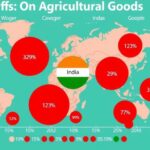Trump’s April 2 Tariff Announcement: Addressing Unfair Trade Practices
President Trump plans to announce reciprocal tariffs on April 2 at 4 PM EST, termed ‘Liberation Day.’ The tariffs specifically target India and Japan, aiming to counter their high tariffs on American goods. Immediate effects on trade and businesses are anticipated, with further tariffs on automobiles commencing April 3. White House Press Secretary criticizes India’s 100% tariffs on agricultural imports.
United States President Donald Trump is preparing to announce reciprocal tariffs against several nations, including India and Japan, on April 2 at 4 PM EST. He has labeled this day as ‘Liberation Day,’ asserting that these tariffs are intended to bolster American businesses. The newly imposed taxes on imported goods will take effect immediately, with additional tariffs on automobiles commencing the following day, April 3.
On the eve of the announcement, White House Press Secretary Karoline Leavitt criticized India for imposing a 100 percent tariff on American agricultural products. She stated, “If you look at the unfair trade practices – we have 50% (tariff) from the European Union on American dairy and a 700% tariff from Japan on American rice. You have a 100% tariff from India on American agricultural products and nearly 300% from Canada on American butter and cheese.”
The tariffs will be revealed during a White House event titled ‘Make America Wealthy Again’ in the Rose Garden. The implementation of these tariffs is expected to have significant repercussions for the United States’ trade relationships, particularly with the over 20 countries with which it has trade agreements, including India.
In conclusion, President Trump’s impending announcement of reciprocal tariffs reflects a strategic push to address perceived unfair trade practices by other nations. The immediate implementation of these tariffs, which includes critiques aimed at high tariffs from countries like India and Japan, marks an assertive shift in US trade policy intended to enhance the competitiveness of American industries.
Original Source: indianexpress.com








Post Comment